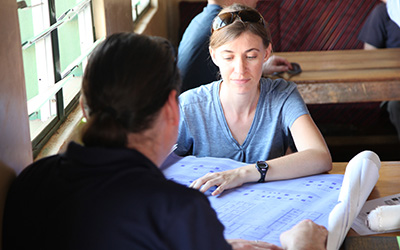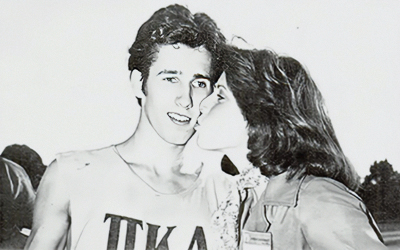When Cheniece Kelleher ’13 couldn’t find children’s books with diverse characters, she wrote her own. Now she’s changing the industry one book at a time.
By Derek Herscovici ’14

Last fall, when I was in baby shower mode and was getting a ton of children’s books, I noticed that there wasn’t much diversity at all. I think “Corduroy” is the only classic, other than “Amazing Grace,” that have Black main characters in them. I started to look into statistics, and I found that as of last year only 12% of children’s books have Black main characters.
I had my son in January and started to intentionally seek out books for him, [but on] Amazon there were so few of what I was looking for. I was on maternity leave until June, and then with the
hospitality-related traveling gone, I was furloughed midyear, [so] I had more time to jump into writing.
What inspired the story?
I remember being in my son’s room at 2 a.m. wondering “what’s going on in his head right now?” and then I wrote the book about the baby who doesn’t want to be put down. In any book, the protagonist has to overcome something—what is that baby going to overcome? I put myself in his shoes, and he was overcoming being alone at naptime by going on a safari adventure with his mom in his dreams.
The baby’s safari-themed nursery and his stuffed giraffe pal, Raffie, were the influence for his safari dream. My experience in the creative agency at Hilton helped me with that creative eye and connecting the details because I probably worked on over 1,000 creative assets for Hilton.
You worked as a marketing consultant for Marriott, and later as an account manager for the Hilton Creative Studio. What did you learn from those experiences?
My clients were the hotel brands. I would work with brands from Waldorf Astoria to Embassy Suites on their hotel signage, websites or digital marketing materials. Basically any pieces of marketing collateral that you would see, from your email confirmation after a hotel booking until you return your room key at the end of your stay.
The digital check-in for Hilton was a really big project. The idea is, you would have the room key on your app—you would [log in] and pick your room without having to go to the front desk. It was a new thing, checking into your room with your phone, and it actually took a lot of consumer education to show it wasn’t a physical task because the key utilized Bluetooth. That was a big learning curve for me—how to communicate with people and encourage them to try something new.
“I like to say that books are windows and mirrors—you get to either be reflected or see into it from an outside perspective.”
Children’s books are as old as time, and there’s probably a children’s book for every topic. There are a lot of animal characters, but studies show that children actually relate more to human characters in books than to animals. Even if the main character doesn’t look like them, to have the background characters look like them is so significant.
When I’m flipping through a book, and I see that someone maybe has a disability or has parents that don’t look alike, or maybe they’re the same gender, it just shows to a child that these things are normal, even if the story is not about that. I like to say that books are windows and mirrors—you get to either be reflected or see into it from an outside perspective.
You got your start in marketing right out of Auburn as an associate brand marketing manager for Under Armour Women. What was that like?
It was a lot of fun! I was immersed in the world of sports and sports marketing and learning how to get athletes to influence others. That was a nice introduction to “influencer marketing” before it got as big as it is today.
I used to travel around the country on my own to find the best fitness trainers and workout classes and try to sign them up for Under Armour. [If] there’s an influential yoga teacher in L.A. that everyone is going to, they are looking at what he or she is wearing. They want those clothes, and they want to be like that person. We set out to find those people and put them in our clothes.
Around the time you finished “Dear Mama’s Loving Arms,” you started your own publishing company, Soaring Kite Books. Why?
As I was starting to finish the book I asked myself “what if I worked with other authors, or even helped other authors, to write their own books?” On my social channels I heard people say, “it would be great if there was an imprint I could get my diverse stories from.”
Right now, traditional publishers are scrambling to get diverse books out because the supply just wasn’t there before. I think by 2022 there will be more from traditional publishers, but I’d encourage everyone to support indie authors telling “own voices” stories. These are authors from underrepresented or marginalized groups telling stories about those groups from their own perspectives.
Building Hope: Disaster Relief Architecture & Design
Combining faith and design, disaster response architect Sarah Elizabeth Dunn ’03 builds shelters for disaster-stricken communities around the world.
Harold Franklin Reflects on Integration 50 Years Later
Fifty years ago, unsure of his safety, a tall, soft-spoken Black man walked alone across the Auburn campus to register for classes.
Auburn Love Stories: How They Met
From blind dates to football games to chance meetings in the classroom, Auburn alums reflect on how they found love and everlasting romance on the Plains.
Building Hope: Disaster Relief Architecture & Design
Combining faith and design, disaster response architect Sarah Elizabeth Dunn ’03 builds shelters for disaster-stricken communities around the world.
Harold Franklin Reflects on Integration 50 Years Later
Fifty years ago, unsure of his safety, a tall, soft-spoken Black man walked alone across the Auburn campus to register for classes.
Auburn Love Stories: How They Met
From blind dates to football games to chance meetings in the classroom, Auburn alums reflect on how they found love and everlasting romance on the Plains.


